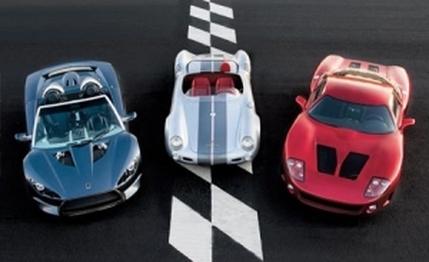
 Specialty File
Specialty File
It's probably fair to say that many of us spent at least some portion of our youths doodling and dreaming of the perfect car we'd one day build. It's an ingrained gearhead dream, the "I could do it better" syndrome. The problem is that few of us are skilled enough to build a car from scratch. But still, the itch persists. So how do you scratch it?
The answer is with a build-it-yourself kit car, one of the ultimate automotive indulgences, a chance to be mechanically intimate with a car in a way that's about impossible to achieve with a modern computer-controlled car. Plus, since a kit car isn't required to meet new-car safety or emissions standards and the labor to build one costs nothing (assuming you build it), kit cars are performance bargains. Then there's the style aspect. A kit car is often the realized version of our doodles.
Those traits are impossible for us to ignore, so we're here with a trio of interesting kit cars that span the vast price, type, and performance spectrum of the genre.
In the vintage replica corner is the Thunder Ranch 550A Spyder. From 10 feet away, it's hard to distinguish the 550A from the Porsche 550 Spyder that won its class at Le Mans in 1954.
The Factory Five Racing GTM LS7 sports a 505-hp Chevy V-8 mounted amidships and weighs a svelte 2496 pounds. That, folks, results in a ratio of only 4.9 pounds per horsepower, which is 22 percent better than that of a $70,000 Corvette Z06. And the GTM costs at least 10 grand less. Call it the supercar of kits.
Hailing from Slovakia, the K-1 Attack uses a reliable front-wheel-drive Honda powertrain that's mounted behind the seats and drives the rear wheels. Its angled body and electrically operated scissors doors get stares usually reserved for Ferraris.
Although we tested, drove, and gave all these cars a thorough once-over, we didn't build them. So we can't say how complete the kits are or how easy they would be to assemble. But we have built two cars in previous years: a VW Beetle-based Kelmark GTS in 1979 and a Caterham in 1998. Judging by the Caterham experience and what we've heard from folks who have built recent kit cars, we believe these vehicles have come a long way since the poorly designed kits of the '70s and '80s. They're reportedly much easier to build.
Every kit, however, is different. Some, like the Caterham, come in many boxes, with every nut and bolt to do the job. Other kit cars we've tested in previous issues—a Noble M400, for example—need only the drivetrain installed before hitting the road.
Doing your homework is easier than ever, thanks to the Internet, where forums offer valuable advice for the home carbuilder. These forums are a good place to find out what different customers paid to put their cars on the road, but pinpointing precise costs is difficult because some builders rely on used parts of varying prices; paint jobs can run the gamut; and shipping costs depend on distances traveled. So, for this story, we've estimated the prices. Also, be sure to investigate your state's laws regarding registering a kit car.
One thing is certain—you'll get an experience that's not available in any showroom.